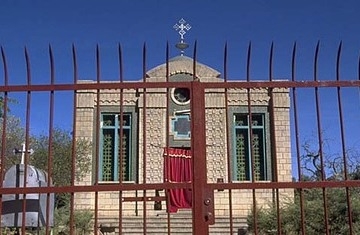
Above: Ethiopians beleive that the true Arc of the Covenant
is housed in this building at Saint Mary’s of Zion in Axum.
Tourists flock to Ethiopia to see Ark of Covenant’s home (The San Diego Union-Tribune)
By Ron Csillag
RELIGION NEWS SERVICE
July 5, 2008
AXUM, Ethiopia – “And they shall make an ark of acacia wood; two and a half cubits shall be its length, a cubit and a half its width, and a cubit and a half its height.”
Such was God’s commandment to Moses in the book of Exodus after delivering the Israelites from slavery in Egypt.
Along with the Holy Grail (said to be the cup Jesus used at the Last Supper), the fabled Ark of the Covenant has become not only an icon of modern culture, thanks mainly to Indiana Jones, but the most revered religious relic of all time.
And in Ethiopia, people really believe it’s here, resting in the Chapel of the Tablet in this northern town just miles from the troubled border with Eritrea.
Ark lore runs deep in this country. Copies of a 1993 book by British journalist Graham Hancock, “The Sign and the Seal,” are displayed everywhere. And every church in Ethiopia has a set of tabots, replicas of the Ten Commandments that were once housed in the Ark.
For one of the poorest countries on Earth to lay claim to the Ark does much to boost its image, not to mention its tourism.
The Ark was the portable wooden chest, gilded inside and out, adorned with cherubs and topped with a throne, that was constructed by the Israelites to house the Ten Commandments during their 40 years of desert wanderings to the Promised Land.
But it was also a kind of supercharged electric capacitor – a telephone line directly to God, who instructed that if the device was set up just right, “There, I will meet with thee.”
Whoever possessed the Ark was invincible. “Biblical and other sources speak of the Ark blazing with fire and light . . . stopping rivers, blasting whole armies,” Hancock writes in his book.
The Bible says the Philistines had it for a while but were smitten by “swellings” for their troubles.
Taken to King Solomon’s first Jewish temple, it lay in the inner sanctum, the Holy of Holies. But according to Jewish tradition, it vanished during (or after) the Babylonian sack of Jerusalem and destruction of the Temple in 586 B.C., creating one of the greatest mysteries of all time.
Except in Ethiopia, where many educated people believe the real Ark rests in the Chapel of the Tablet, where it was moved from an adjacent 10th-century cathedral because divine “heat” from the relic had cracked the stones of its previous sanctum.
As the story goes, the Queen of Sheba, one of Ethiopia’s first rulers, traveled to Jerusalem to partake of King Solomon’s wisdom. On her way home, she bore the king’s son, Menelik.
After Menelik went to Jerusalem to visit his father, Solomon gave him a copy of the Ark and commanded that officials of his kingdom travel back to Ethiopia to settle there.
But the royal entourage that was traveling to Ethiopia could not bear to be away from the Ark, so they switched the copy with the original and smuggled the real thing out of the country. Menelik learned of this only on his way home and reasoned that since the Ark’s powers hadn’t destroyed his entourage, it must be God’s will that it remain in Ethiopia. Read More.

























